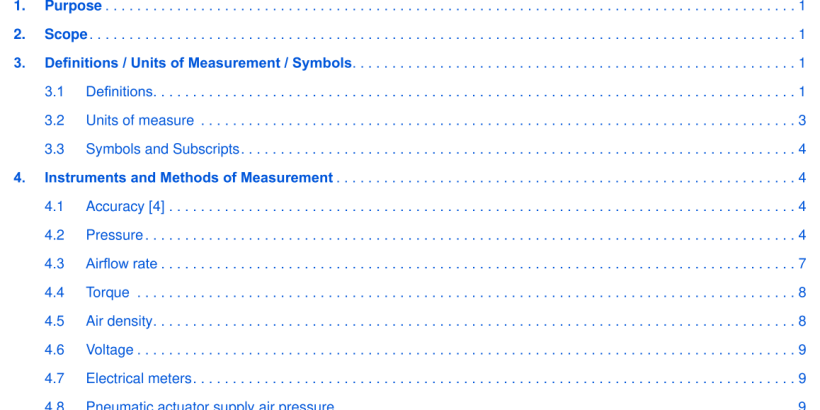ANSI AMCA 500-D-2012 pdf download.Laboratory Methods of Testing Dampers for Rating
3.1.7.4 Ambient temperature dynamic closure Ambient temperature (0 °C – 49 °C (32 °F – 120 °F)) dynamic closure is the ability of a damper to properly travel from the full open to the full closed position while exposed to specifc airfow conditions at ambient temperature. The specifc air- fow conditions are the airfow face velocity when the damp- er is in the open position and the pressure differential across the damper in the closed position. The airfow face velocity is the velocity established with the damper in the open posi- tion. The pressure differential is established when the damp- er is in the closed position. All airfow measurements and pressure differential measurements are established at ambi- ent conditions and are corrected to standard air. The damp- er can be tested in either a ducted or in-wall installation.
3.1.7.5 Elevated temperature dynamic closure Elevated temperature dynamic closure is the ability of a damper to properly travel from the full open to the full closed position while exposed to specifc airfow conditions at a specifed elevated air temperature. The specifc airfow conditions are the airfow face velocity when the damper is in the open position and the pressure differential across the damper in the closed position. The air- fow face velocity is the velocity established with the damp- er in the open position. The pressure differential is estab- lished when the damper is in the closed position. All airfow measurements and pressure differential measurements are established at ambient conditions and are corrected to stan- dard air. This test is conducted in a ducted installation only.
3.1.7.7 Elevated temperature operation
Elevated temperature operation is the operational ability of a damper to properly travel from full open to full closed posi- tion at elevated temperatures and, if a motorized damper, operate back to a full open position while exposed to spec- ifed airfow conditions. The specifed airfow conditions are the airfow face velocity when the damper is in the open position and the pressure differential across the damper in the closed position. The airfow face velocity is the veloci- ty established when the damper is in the open position. The pressure differential is established when the damper is in the closed position. All airfow measurements are estab- lished at ambient temperature conditions and are correct- ed to standard air.
3.1.7.8 Dynamic operation torque
Dynamic operation torque is the torque at varying angles of rotation of the axle which operates the damper from the full open, to the full closed, and back to the full open position while exposed to specifc airfow conditions. The specifc air- fow conditions are the airfow face velocity when the damp- er is in the open position and the pressure differential across the damper in the closed position. All airfow measurements and pressure differential measure-ments are established at ambient conditions and are corrected to standard air.
4.2.1 General
The total pressure at a point shall be measured on an indi- cator, such as a manometer, with one leg open to atmo- sphere and the other leg connected to a total pressure sen- sor, such as a total pressure tube or the impact tap of a Pitot-static tube. The static pressure at a point shall be mea- sured on an indicator, such as a manometer, with one leg open to the atmosphere and the other leg connected to a static pressure sensor, such as a static pressure tap or the static tap of a Pitot-static tube. The velocity pressure at a point shall be measured on an indicator, such as a manom- eter, with one leg connected to a total pressure sensor, such as the impact tap of a Pitot-static tube, and the other leg connected to a static pressure sensor, such as the static tap of the same Pitot-static tube. The differential pressure between two points shall be measured on an indicator, such as a manometer, with one leg connected to the upstream sensor, such as a static pressure tap, and the other leg con- nected to the downstream sensor, such as a static pressure tap.ANSI AMCA 500-D-2012 pdf download
